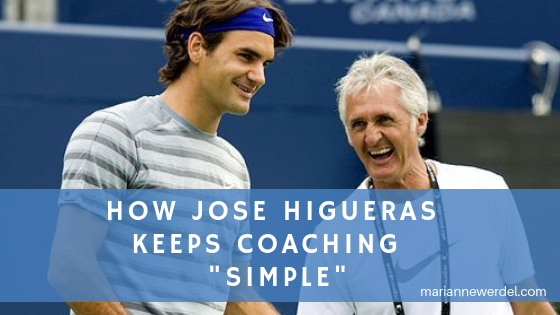How Jose Higueras Keeps Coaching “SIMPLE”

Last week, I attended the USTA High Performance Coaching Symposium during the Qualifying week at the US Open. There was an abundance of information to digest, with technology, biomechanics, and performance teams, but it was Jose Higueras who was able to bring it all together and make it relevant to what we do on the court every day as coaches.

Jose Higueras is widely known as one of the greatest coaching minds of all time. In his playing career, Jose won 16 ATP singles titles and was ranked as high as No. 6 in the world. Following his retirement, he made the transition from professional player to professional coach and began to pass on his knowledge and his passion for the game.
Jose has coached the likes of Michael Chang, Jim Courier, Mary Joe Fernandez, Pete Sampras, Carlos Moya, Todd Martin, Jennifer Capriati, Robby Ginepri, and Roger Federer…to name a few. Jose now spends much of his time, sharing his coaching knowledge with other coaches.
How Jose Higueras Keeps Coaching “SIMPLE”.
“Coaching is about how we take the information, how we apply the information. And then, how we implement it with the kids.”
Keep It Simple
The coach’s job is to assemble the information and keeping it simple when communicating to the player. The worst thing for a player is to overthink it during a match. Too much information makes things complicated. Keep it SIMPLE!
Repetitions

There is NO substitute for repetitions. We watched Rafa Nadal finish his practice on Wednesday with about 50 hand fed balls to his backhand. As a coach, look at what your player can do. See what needs to be added. Ask yourself, what do you have to do to make a shot? You have to hit it a bunch of times. Add those drills with A LOT of repetitions. Over and over. There is no other way.
Progressions
When teaching new skills, think of learning math.
Over-Coaching
Kids don’t learn because we tell them. Kids learn by feeling and experiencing it. They learn by figuring it out themselves. Don’t give them the answers! Create drills and match play to let them figure it out.
Failing
A player doesn’t get better without failing. Failing is part of the learning process to grow and get better. They have to be put in a situation over and over and FAIL in order to learn.
Practice

A player’s practice must be harder than any match they will play. A player must fear practice more than any opponent. Their practice must make them uncomfortable with a high level of stress to build resiliency and confidence.
Standards
As a professional coach, you must have standards. You do not adjust or compromise your standards to fit the player. If the player and the family are not a good fit for your standards, then they need to find another coach.
There were a few of us at the symposium who had been fortunate enough to have worked on court with Jose during our playing careers. Here are a few of the “Jose-is ms” that Tony Bujan and I remember and use in our coaching today.
1. Out wide, Up high.
When you are pulled out wide, get the ball up high to give yourself time to recover. As the kids get older, they can learn to hit heavy spin out of the corner, and then the flat ball down the line.
2. You can take it on the rise, but it better rise.
Kids today don’t move up and back off the baseline as well as they move side to side. It is great to take the ball on the rise, to take time away from your opponent, but you have to let it rise into your strike zone. Do NOT hit it on the rise between your knees and ankles.
3. If you slice, it better find the court.
The slice is used to defend, or as a changeup, it is generally not used to finish a point, so don’t make an error.
4. Resist the temptation to hit a winner.
Errors come when we are forcing a winner. Work the point until the opening happens, and the next shot becomes a winner. You get the discipline through all the repetitions.
5. You don’t have to “like” all of them, but have to “like” some of them.
When you are trying to teach a player to move forward, don’t force them to come forward on EVERY opportunity. Make them pick some of them and gradually, they will “like” more and more opportunities.
6. Hit the ball as hard as you want, but it better go in!
Rip the ball as hard as you want, but you need spin and conservative targets to keep it in the court.
If any of you have an opportunity to participate in a USTA
Thank you for reading, and keep it SIMPLE!

Related Posts
Student-Athlete’s Recruiting Workbook
“College is a match to be made, not a prize to be won.”…
August 27, 2019Five Tips to Make Adversity Plus Failure Equal Success!
Thank you, Debbie Graham Shaffer, for sharing a great piece on the importance of our…
August 27, 2019

